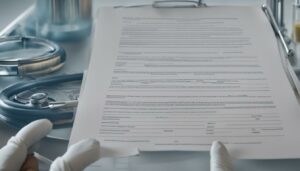In a personal injury case, determining who is liable is crucial. The liable party is the one responsible for bearing the costs of any damages resulting from an accident. Liability is determined based on legal concepts such as negligence and fault. It is important to understand the legal definition of liability and how it is assigned in order to navigate personal injury cases successfully.
Key Takeaways:
- Identifying the liable party is essential in personal injury cases.
- Liability is based on legal concepts like negligence and fault.
- Understanding the legal definition of liability is crucial for successful case navigation.
- Consulting with a personal injury attorney can help ensure fair representation.
- Evidence plays a crucial role in determining liability in personal injury cases.
Related Post: Personal Injury Cases – The Process
What is Liability in Personal Injury Law?
In personal injury law, liability refers to the legal responsibility of an individual or entity for causing harm or injury to another person. It is based on the concept of negligence, which is the failure to exercise reasonable care that leads to injury or harm. Liability can also be determined by proving fault, either directly or indirectly, through evidence presented in a case. In order to establish liability, it is crucial to demonstrate that the defendant had a duty of care, breached that duty, and caused the plaintiff’s injury or harm.
In personal injury cases, liability is often established through the legal principle of negligence. This means that the plaintiff must prove that the defendant had a duty to act with reasonable care, failed to do so, and that this failure caused the plaintiff’s injury. For example, in a car accident case, the plaintiff may argue that the defendant was negligent in speeding or running a red light, resulting in the collision and the plaintiff’s injuries.
Liability can also be determined by proving fault, either directly or indirectly, through evidence presented in a case.
In addition to negligence, other theories of liability can be applied in personal injury cases. These theories include strict liability, which holds the defendant responsible for harm regardless of negligence or intent, and vicarious liability, which holds one party responsible for the actions of another. Understanding these different theories is important in determining the appropriate grounds for establishing liability in a personal injury case.
| Types of Liability Theories in Personal Injury Cases | Description |
|---|---|
| Negligence | The defendant failed to exercise reasonable care, leading to the plaintiff’s injury. |
| Strict Liability | The defendant is held responsible for harm regardless of negligence or intent. |
| Vicarious Liability | One party is held responsible for the actions of another. |
How is Liability Determined in Personal Injury Cases?
Liability in personal injury cases can be determined in various ways. In some cases, an admission of responsibility by one party may be enough to establish liability. However, in other cases, a jury may need to hear the evidence presented by all parties involved before assigning liability. Evidence such as witness accounts, physical evidence, and accident reports can play a crucial role in determining liability. It is important to consult with a personal injury attorney to ensure a fair representation and understanding of who is liable for damages in your case.
Factors Considered in Determining Liability
When determining liability in personal injury cases, several factors are taken into consideration. These factors include:
- The nature and extent of the injuries
- The circumstances surrounding the accident
- Any applicable laws and regulations
- Evidence of negligence or fault
By carefully analyzing these factors, a legal professional can assess the strength of a personal injury case and determine the most appropriate course of action.
Importance of Legal Representation
Having proper legal representation is essential when it comes to establishing liability in personal injury cases. An experienced personal injury attorney can help gather and present evidence, negotiate with insurance companies, and fight for fair compensation on behalf of their clients. They have a deep understanding of personal injury laws and can navigate the complex legal process to ensure the best possible outcome.
Additionally, a personal injury attorney can provide the necessary guidance and support throughout the case, offering expert advice and ensuring that the injured party’s rights are protected at all times.
| Benefits of Legal Representation in Personal Injury Cases |
|---|
| Expert knowledge of personal injury laws and regulations |
| Access to resources and networks for thorough investigation and evidence collection |
| Experience in negotiating with insurance companies for fair settlements |
| Ability to build a strong case by presenting compelling evidence and arguments |
| Representation and advocacy in court proceedings, if necessary |
Different Types of Liability Theories in Personal Injury Cases
In personal injury cases, there are several types of liability theories that can be applied. Understanding these theories is essential for determining the appropriate grounds for establishing liability. Here are the main types of liability theories commonly used:
Negligence
Negligence is one of the most common theories in personal injury cases. To prove negligence, the plaintiff must demonstrate that the defendant acted negligently and that their actions directly caused the injury or harm. This requires showing that the defendant had a duty of care, breached that duty, and that the breach caused the plaintiff’s injury.
Comparative Negligence
Comparative negligence is a theory that considers the actions of both the plaintiff and the defendant in determining liability. If both parties share some degree of fault, the percentage of fault will be assigned to each party. The plaintiff’s compensation may be reduced based on their assigned percentage of fault.
Strict Liability
Strict liability is a theory that holds a defendant responsible for the injuries or damages caused, regardless of fault or intent. This theory is often applied in cases involving defective products or certain hazardous activities where the risk of harm is inherent.
Vicarious Liability
Vicarious liability is a theory that holds one party legally responsible for the actions of another party. This is commonly seen in employer-employee relationships, where an employer may be held liable for the negligent actions of their employee if those actions occurred within the scope of employment.
Negligence Per Se
Negligence per se is a theory that shifts the burden of proof to the defendant if they violated a safety law or regulation that is intended to protect the public. In this case, the plaintiff does not need to prove negligence, as it is presumed based on the defendant’s violation of the law.
Understanding these different types of liability theories can help strengthen your personal injury case and determine the appropriate legal strategy. Consultation with a personal injury attorney is highly recommended to ensure a comprehensive understanding of the liability theories applicable to your specific situation.
Proving Liability in Court
Proving liability in court requires presenting compelling evidence to establish key elements of a personal injury case. The burden of proof lies with the plaintiff, who must demonstrate that the defendant owed a duty of care, breached that duty, and caused the plaintiff’s injury. It is essential to gather sufficient evidence to support these claims and convince the court of the defendant’s liability.
Evidence plays a crucial role in proving liability. This can include witness testimony, expert opinions, accident reports, medical records, and any other relevant documentation. By presenting a strong case with compelling evidence, the plaintiff can strengthen their chances of a successful outcome in court.
In addition to proving duty of care, breach of duty, and causation, it is also important to show that the plaintiff suffered damages as a result of the defendant’s actions. This can include physical injuries, medical expenses, lost wages, pain and suffering, and other related losses. Providing evidence of these damages can strengthen the plaintiff’s case and help establish the extent of the defendant’s liability.
| Evidence Required to Prove Liability in Court | |||
|---|---|---|---|
| Duty of care | Breach of duty | Causation | Damages |
| Witness testimony | Expert opinions | Accident reports | Medical records |
| Photographs or videos | Financial records | Employment records | Testimonials |
Multiple Parties and Shared Liability
In some personal injury cases, determining liability is not as straightforward as identifying a single party responsible for the accident or injury. Instead, multiple parties may share liability, meaning that each party contributed to the cause of the incident. This can occur in situations where more than one person or entity has played a role in the accident.
When multiple parties are at fault, a jury or court may assign a percentage of blame to each party involved. This percentage reflects the level of contribution each party made to the accident or injury. For example, if a car accident occurred due to the negligence of both the driver and the highway department, the jury may assign a percentage of liability to each party.
Once the percentage of liability is determined, it is used to divide the amount of damages awarded in the case. Each party is then responsible for paying their assigned percentage of the total damages. This approach ensures that each party bears financial responsibility in proportion to their level of fault. For the injured party, it means that they may be able to recover the compensation they are entitled to from multiple sources.
| Party | Percentage of Liability |
|---|---|
| Driver | 60% |
| Highway Department | 40% |
It is important to note that shared liability can affect the amount of compensation a plaintiff receives. If the injured party is found to be partially at fault for the accident, their compensation may be reduced according to their assigned percentage of liability. However, as long as the injured party is less than 50% responsible, they may still be eligible to recover some compensation from the other parties involved.
Consulting with a personal injury attorney is crucial in cases involving shared liability. An experienced attorney can help navigate the legal complexities and ensure that your rights are protected. They will advocate for your best interests, gather evidence to support your case, and negotiate with the other parties involved to secure a fair settlement or represent you in court if necessary.
Liability Insurance and Settlements
When it comes to personal injury cases, liability insurance plays a crucial role in determining who is responsible for the damages. Typically, the at-fault party in an accident will have liability insurance coverage. This means that the injured party can file a claim with the at-fault party’s insurance company to seek compensation for their injuries and losses.
The insurance company will then conduct an investigation to determine liability. If the at-fault party’s liability is accepted, the insurance company may offer a settlement to the injured party. The settlement amount is typically negotiated between the injured party and the insurance company, taking into account factors such as medical expenses, property damage, lost wages, and pain and suffering.
However, there are cases where there is a dispute over liability. In such situations, the injured party and their attorney may choose to file a personal injury lawsuit. In a lawsuit, the court will ultimately decide who is liable for the damages based on the evidence presented. It is important to note that even if a settlement is reached, it is still subject to court approval and can be rejected if the court deems it unfair or inadequate.
Table: Liability Insurance Coverage and Settlements
| Insurance Company | Settlement Offer |
|---|---|
| AXA | $50,000 |
| BUPA | $100,000 |
| AIA | $75,000 |
As shown in the table above, different insurance companies may offer varying settlement amounts. It is important for the injured party to carefully review any settlement offers and seek legal advice to ensure they are receiving fair compensation for their injuries and losses.

The Importance of Legal Representation in Personal Injury Cases
When it comes to personal injury cases, having experienced legal representation is of utmost importance. The legal proceedings can be complex, and accurate accounting of the evidence is crucial for establishing liability. An experienced attorney can navigate the intricacies of the legal system, ensuring fair representation and a thorough understanding of your rights and options.
One of the key roles of an attorney in a personal injury case is to gather and present evidence to establish liability. They have the expertise to collect the necessary evidence, such as witness testimony and expert opinions, and present it in a compelling manner to support your case. This includes ensuring that any statements made are within the proper context and not misinterpreted by others.
“Having an attorney by your side throughout the legal proceedings can ensure fair representation and increase your chances of a favorable outcome.”
Furthermore, an attorney can accurately assess the damages suffered as a result of the personal injury. They will take into account medical bills, lost wages, and any other relevant factors to determine the appropriate compensation. This accurate accounting is essential for ensuring that you receive fair compensation for your injuries.
Importance of Experienced and Fair Representation
Choosing an experienced personal injury attorney is crucial for achieving a favorable outcome. They have a deep understanding of personal injury laws and can provide valuable legal advice tailored to your specific situation. With their expertise, they can guide you through the legal proceedings, ensuring that you present the strongest possible case to establish liability and receive fair compensation.
In conclusion, the importance of legal representation in personal injury cases cannot be overstated. An experienced attorney will provide accurate accounting of the evidence, ensure fair representation, and increase your chances of a favorable outcome. If you have been injured due to someone else’s negligence, it is crucial to seek the guidance of a personal injury attorney to protect your rights and pursue the compensation you deserve.
| Benefits of Legal Representation in Personal Injury Cases |
|---|
| Accurate accounting of evidence |
| Expertise in gathering and presenting evidence |
| Thorough understanding of personal injury laws |
| Guidance through the legal proceedings |
| Fair representation to establish liability |
| Increase chances of a favorable outcome |
Understanding Contributory Negligence and its Impact on Liability
In personal injury cases involving multiple parties, the concept of contributory negligence can greatly impact liability and the resulting compensation. Contributory negligence refers to the idea that the injured party may have contributed to the accident or injury in some way. When multiple parties are responsible, each party’s percentage of liability is determined, and the injured party’s compensation is adjusted accordingly.
For example, let’s consider a car accident case where both the plaintiff and the defendant were found to have contributed to the collision. If the court determines that the plaintiff was 20% at fault and the defendant was 80% at fault, the plaintiff’s compensation would be reduced by their assigned percentage of liability. So, if the total damages awarded were $100,000, the plaintiff would receive $80,000, representing their 80% share of the liability.
It is important to note that, in some instances, if the injured party is deemed to be more than 50% responsible for the accident, they may be barred from recovering any compensation. Therefore, the assessment of contributory negligence and the determination of liability can significantly impact the outcome of a personal injury case.
The Impact of Contributory Negligence on Compensation:
Contributory negligence not only affects the amount of compensation an injured party may receive, but it also plays a vital role in negotiations and settlements. Insurance companies and defense attorneys may argue that the injured party’s contribution to the accident diminishes their claim’s value. They may use evidence and arguments to shift a higher percentage of liability onto the injured party, reducing their potential compensation.
In light of these complexities, it is crucial for individuals involved in personal injury cases to seek legal representation. A knowledgeable personal injury attorney can assess the circumstances of the case, gather evidence, and advocate for the injured party’s rights. They can also negotiate with insurance companies or represent the injured party in court, ensuring a fair determination of liability and maximum compensation.
By comprehending the concept of contributory negligence and its impact on liability, injured parties and their legal representatives can navigate the complexities of personal injury cases more effectively. Understanding one’s own contribution to an accident or injury and proactively addressing it within the legal process can help ensure a fair and just outcome.
| Contributory Negligence | Impact on Liability |
|---|---|
| Injured party found to be less than 50% responsible | Compensation reduced by assigned percentage of liability |
| Injured party deemed more than 50% responsible | Barred from recovering any compensation |
| Contributory negligence argument | May reduce injured party’s potential compensation |
| Legal representation | Crucial in navigating contributory negligence complexities |
Seek Legal Advice for Establishing Liability in Personal Injury Cases
If you’ve been involved in a personal injury case, it’s crucial to seek legal advice to establish liability and protect your rights. A personal injury attorney can provide you with the guidance and support needed to navigate through the complex legal process.
One of the key roles of a personal injury attorney is to help you with evidence collection. They have the knowledge and experience to gather the necessary evidence to establish liability, such as accident reports, medical records, and witness testimonies. By carefully analyzing the evidence, they can build a strong case on your behalf.
When you consult with a personal injury attorney, you can expect a free consultation where you can discuss the details of your case. During this initial meeting, they will listen to your story, evaluate the evidence you have, and provide you with legal advice tailored to your specific situation. They will explain your options and help you understand the best course of action to achieve a favorable outcome.
Remember, seeking legal advice is crucial in personal injury cases. By working with a personal injury attorney who specializes in establishing liability, you can maximize your chances of receiving the compensation you deserve. Don’t hesitate to reach out for a free consultation to protect your rights and seek justice.
FAQ
What does liability mean in a personal injury case?
Liability refers to the legal responsibility of an individual or entity for causing harm or injury to another person.
How is liability determined in personal injury cases?
Liability can be determined based on legal concepts such as negligence and fault, and it is established through evidence presented in a case.
What are the different types of liability theories in personal injury cases?
The different types of liability theories include negligence, comparative negligence, strict liability, vicarious liability, and negligence per se.
What is required to prove liability in court?
Proving liability in court requires demonstrating that the defendant owed a duty of care, breached that duty, and caused the plaintiff’s injury, resulting in damages.
Can multiple parties share liability in a personal injury case?
Yes, multiple parties can share liability if more than one person or entity contributed to the cause of the accident or injury.
What role does liability insurance play in personal injury cases?
The at-fault party in a personal injury case usually has liability insurance, which allows the injured party to file a claim for compensation.
Why is legal representation important in personal injury cases?
Having an experienced attorney is crucial as they can provide guidance, collect evidence, and build a strong case to establish liability and ensure fair representation.
What is contributory negligence and how does it impact liability?
Contributory negligence is a legal concept that reduces compensation if the injured party is found to have contributed to the accident or injury.
Why should I seek legal advice for establishing liability in a personal injury case?
Seeking legal advice ensures that you have the necessary support and guidance to collect evidence, understand your rights, and navigate the legal process effectively.










